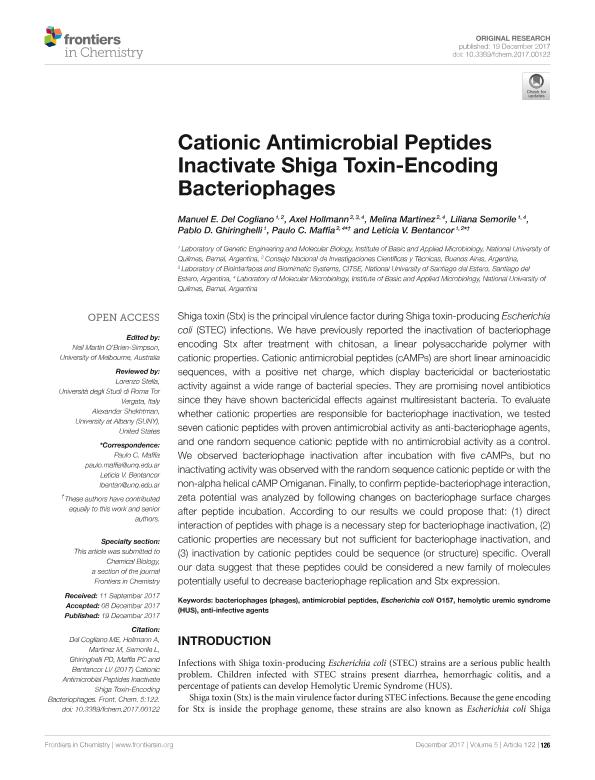Mostrar el registro sencillo del ítem
dc.contributor.author
del Cogliano, Manuel Eugenio

dc.contributor.author
Hollmann, Axel

dc.contributor.author
Martínez, Melina María Belén

dc.contributor.author
Semorile, Liliana Carmen

dc.contributor.author
Ghiringhelli, Pablo Daniel

dc.contributor.author
Maffia, Paulo Cesar

dc.contributor.author
Bentancor, Leticia Verónica

dc.contributor.other
O´Brien Simpson, Neil M.
dc.contributor.other
Hoffmann, Ralf

dc.contributor.other
Brian Chia, C. S.
dc.contributor.other
Wade, John D.
dc.date.available
2020-06-03T20:16:59Z
dc.date.issued
2018
dc.identifier.citation
del Cogliano, Manuel Eugenio; Hollmann, Axel; Martínez, Melina María Belén; Semorile, Liliana Carmen; Ghiringhelli, Pablo Daniel; et al.; Cationic antimicrobial peptides inactivate shiga toxin-encoding bacteriophages; Frontiers Media S.A.; 2018; 126-131
dc.identifier.isbn
978-2-88945-470-9
dc.identifier.uri
http://hdl.handle.net/11336/106633
dc.description.abstract
Shiga toxin (Stx) is the principal virulence factor during Shiga toxin-producing Escherichia coli (STEC) infections. We have previously reported the inactivation of bacteriophage encoding Stx after treatment with chitosan, a linear polysaccharide polymer with cationic properties. Cationic antimicrobial peptides (cAMPs) are short linear aminoacidic sequences, with a positive net charge, which display bactericidal or bacteriostatic activity against a wide range of bacterial species. They are promising novel antibiotics since they have shown bactericidal effects against multiresistant bacteria. To evaluate whether cationic properties are responsible for bacteriophage inactivation, we tested seven cationic peptides with proven antimicrobial activity as anti-bacteriophage agents, and one random sequence cationic peptide with no antimicrobial activity as a control. We observed bacteriophage inactivation after incubation with five cAMPs, but no inactivating activity was observed with the random sequence cationic peptide or with the non-alpha helical cAMP Omiganan. Finally, to confirm peptide-bacteriophage interaction, zeta potential was analyzed by following changes on bacteriophage surface charges after peptide incubation. According to our results we could propose that: (1) direct interaction of peptides with phage is a necessary step for bacteriophage inactivation, (2) cationic properties are necessary but not sufficient for bacteriophage inactivation, and (3) inactivation by cationic peptides could be sequence (or structure) specific. Overall our data suggest that these peptides could be considered a new family of molecules potentially useful to decrease bacteriophage replication and Stx expression.
dc.format
application/pdf
dc.language.iso
eng
dc.publisher
Frontiers Media S.A.

dc.rights
info:eu-repo/semantics/openAccess
dc.rights.uri
https://creativecommons.org/licenses/by/2.5/ar/
dc.subject
Synthetic peptides
dc.subject
Antimicrobial peptides
dc.subject.classification
Biología Celular, Microbiología

dc.subject.classification
Ciencias Biológicas

dc.subject.classification
CIENCIAS NATURALES Y EXACTAS

dc.title
Cationic antimicrobial peptides inactivate shiga toxin-encoding bacteriophages
dc.type
info:eu-repo/semantics/publishedVersion
dc.type
info:eu-repo/semantics/bookPart
dc.type
info:ar-repo/semantics/parte de libro
dc.date.updated
2020-02-19T19:53:42Z
dc.journal.pagination
126-131
dc.journal.pais
Suiza

dc.description.fil
Fil: del Cogliano, Manuel Eugenio. Universidad Nacional de Quilmes. Departamento de Ciencia y Tecnología. Laboratorio de Ingeniería Genética y Biología Molecular y Celular; Argentina. Consejo Nacional de Investigaciones Científicas y Técnicas; Argentina
dc.description.fil
Fil: Hollmann, Axel. Consejo Nacional de Investigaciones Científicas y Técnicas. Centro de Investigaciones y Transferencia de Santiago del Estero. Universidad Nacional de Santiago del Estero. Centro de Investigaciones y Transferencia de Santiago del Estero; Argentina. Universidad Nacional de Quilmes; Argentina
dc.description.fil
Fil: Martínez, Melina María Belén. Universidad Nacional de Quilmes. Departamento de Ciencia y Tecnologia. Instituto de Microbiologia Basica y Aplicada. Laboratorio de Micologia Molecular.; Argentina. Consejo Nacional de Investigaciones Científicas y Técnicas; Argentina
dc.description.fil
Fil: Semorile, Liliana Carmen. Universidad Nacional de Quilmes. Departamento de Ciencia y Tecnologia. Instituto de Microbiologia Basica y Aplicada. Laboratorio de Micologia Molecular.; Argentina. Universidad Nacional de Quilmes. Departamento de Ciencia y Tecnología. Laboratorio de Ingeniería Genética y Biología Molecular y Celular; Argentina
dc.description.fil
Fil: Ghiringhelli, Pablo Daniel. Universidad Nacional de Quilmes. Departamento de Ciencia y Tecnología. Laboratorio de Ingeniería Genética y Biología Molecular y Celular; Argentina. Consejo Nacional de Investigaciones Científicas y Técnicas; Argentina
dc.description.fil
Fil: Maffia, Paulo Cesar. Universidad Nacional de Quilmes. Departamento de Ciencia y Tecnologia. Instituto de Microbiologia Basica y Aplicada. Laboratorio de Micologia Molecular.; Argentina. Consejo Nacional de Investigaciones Científicas y Técnicas; Argentina
dc.description.fil
Fil: Bentancor, Leticia Verónica. Universidad Nacional de Quilmes. Departamento de Ciencia y Tecnología. Laboratorio de Ingeniería Genética y Biología Molecular y Celular; Argentina. Consejo Nacional de Investigaciones Científicas y Técnicas; Argentina
dc.relation.alternativeid
info:eu-repo/semantics/altIdentifier/doi/https://doi.org/10.3389/fchem.2017.00122
dc.relation.alternativeid
info:eu-repo/semantics/altIdentifier/url/https://www.frontiersin.org/articles/10.3389/fchem.2017.00122/full
dc.conicet.paginas
135
dc.source.titulo
Antimicrobial and anticancer peptides
Archivos asociados
